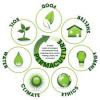GBM Blog
CLIMATE CHANGE ADAPTIVE MEASURE THROUGH PERMACULTURE IN SAMBURU COUNTY
This blog was written by Christine Okila, Communications GBM.
Samburu County is predominantly semi-arid with a scarce erratic rainfall (mean annual rainfall of between 500-700mm per annum). Increased human dependence on forest resources along with variability in intensity and seasonality of rainfall, have resulted in prolonged drought and severe weather events in recent years. Kirisia forest, one of four forest reserves in Samburu, has been badly encroached and poorly managed, and is subject to fierce and destructive fires. Illegal extraction of cedar, collection of firewood, charcoal burning, cutting down trees for fodder and overharvesting of herbs and non-wood forest products are main threats to Kirisia forest and its ecosystem functioning.
Samburu communities are culturally pastoralists - 88% of the community household income comes from livestock rearing, with 98% of the community using fuel wood as a source of energy, but only 30% of the community engages in tree planting to help maintain a viable source of wood and forest system.
Due to vulnerability caused by changing weather patterns and the serious degradation of the existing forests, communities living in this area will need to deal over the coming period with greater climate change. It is necessary to start now to educate and help bring human activities into better harmony with the ecosystem that sustains them.
In 2014 the Green Belt Movement began a new project using permaculture. Permaculture, according to the editor of Permaculture magazine Maddy Harland “is primarily a thinking tool for designing low carbon, highly productive ways of living”. Working with communities to design and integrate ecological knowledge into their daily activities could help the pastoralists of Samburu to cope better with the impacts of climate change.
A permaculture approach includes sustainable agriculture, simple water harvesting technologies, value addition and post harvesting care.
Permaculture makes it possible to grow food, trees and fodder while enhancing water quality and abundance, increasing bio-diversity, conserving soil and increasing community food security, health and agricultural productivity.

PERMACULTURE is working with, rather than against, nature!
GBM in partnership with Prince Albert II of Monaco Foundation and Yves Rocher Foundation engaged Dr. Thuita Thenya and Dr. Cecilia Onyango, lecturer from University of Nairobi – Kenya, to implement permaculture with Samburu community. GBM has been able to initiate 3 demonstration sites in Tamiyoi, Bawa and Porro in the Kirisia ecosystem as a climate change adaptation measure.
The permaculture initiative is supporting 45 Samburu community members with practical training which includes sustainable agricultural practices, post-harvest management, pest control, value addition and simple water harvesting techniques.
The community members start by selecting food crops that they are willing to plant and that can withstand challenging climate. Also, by learning post-harvest land management techniques they will be able to harvest fodder to be used during dry seasons.
The 45 trainees will then train other community members and upscale the initiative. The aim is to introduce a more sustainable farming approach that will enable communities to produce food crops and livelihoods despite the increasingly variable rainfall.
The permaculture approach does not only involve a change into farming styles but also how communities look at the land and its management. Some scientists are predicting that the communities in Samburu will have to undertake radical anthropological changes in order to cope to climate change changing from nomadic to sedentary lifestyles. Our approach is to support communities as they grapple with the present and advance impacts of climate change.
The 45 community members trained so far are starting to help the communities to create greater resilience in the face of climate change.


Figure 1. Community members preparing permaculture site at Baawa demonstration site. The land layout plan was drawn and community identified crop varieties to be grown
